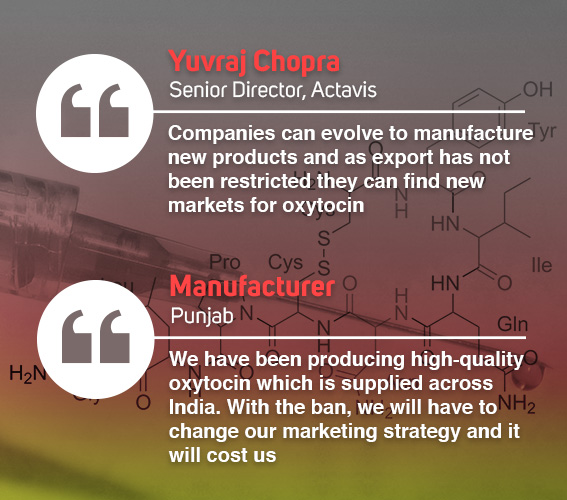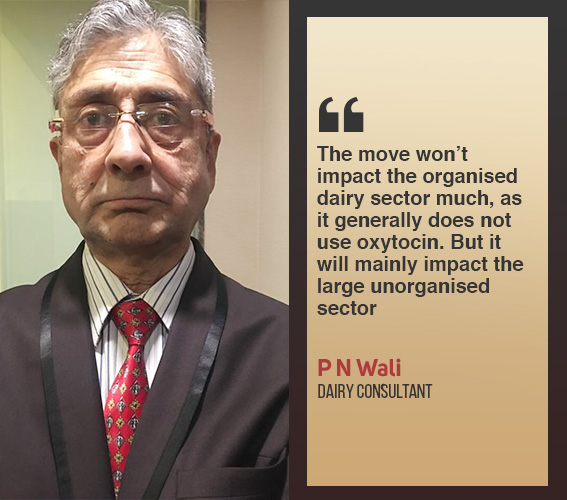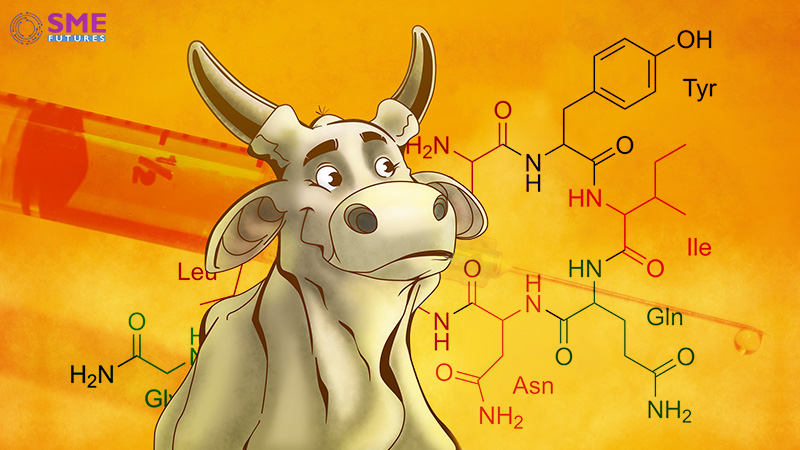Known as the love hormone, oxytocin has been breaking many a heart ever since the Government of India recently banned its import and restricted production to public sector undertakings after reports of misuse accumulated over the years. The import ban came into effect immediately, while the regulations will be implemented from 1 July. Currently, there are more than 60 private companies across India that manufacture the hormone who stare at an immediate future where their revenue will take a major hit or they may have to shut shop; and, that too for no fault of theirs, the manufacturers lament. The government move shows them in poor light, they feel. “What really hurts us is that we are not doing anything illegal. In fact, our drugs go to hospitals and clinics,” says a manufacturer, on condition of anonymity.
The ban includes import of oxytocin formulations, while the restrictions will cover sale as well. The trigger for the decision came from reported misuse of the hormone. While recognised by the government as a life-saving drug, it is clandestinely manufactured without any prerequisite licensing or safety standards in illegal labs. However, those in the business say that curbs will have little impact on such illegal manufacturing. “We had pretty good marketing strategies and networks. Now that government is taking over, I fail to understand how they will supply oxytocin to all the hospitals and clinics directly. Also, I am doubtful if the PSUs can meet the demand,” says an industry insider.
Bearing the brunt
The decision to restrict production and supply of oxytocin in the domestic market came after a campaign against its use on dairy animals. Spearheaded by animal rights activist and women and child development minister Maneka Gandhi, the campaign sought to draw attention to the pain that the milch animals had to endure when administered oxytocin for milk augmentation.
However, generic drug manufacturing companies feel that they are being targeted unfairly. “The problem is not with the legally produced oxytocin, but the illegal factories,” says a manufacturer in Punjab, who does not wish to be named. “We have established our brand around manufacturing oxytocin in the past 20 years. We have been producing high-quality oxytocin, which is supplied across India. With the ban, we will have to change our marketing strategy, which will cost us heavily,” he adds. He does not believe that the ban will help anyone. Explaining the hazard of the illegally manufactured hormone, he says that in such cases no one knows what amount each vial has, which makes it risky to use. He claims he has been calling for drug inspectors to visit dairy farms to crack down on the illegal trade, but not much has been done. According to industry sources, many manufacturers in rural areas supply 100 ml or 200 ml vials to dairy farms.

Yuvraj Chopra, a senior director in global pharmaceutical giant Actavis, says, “Obviously this decision will impact pharmaceutical companies. But companies can evolve to manufacture new products and as export has not been restricted they can find new markets for oxytocin. Indian oxytocin products are of high quality and cheap, so expanding operations overseas can be an option.”
A pharma industry insider reiterates that rules would not deter malpractices. “If people have to find a way, they will. The black market for the product will continue to exist, just like the pirated CD market continues to exist. There is a need to create a mechanism to make sure that the drug is not manufactured illegally. Regulation alone does not help. The government needs to have drug inspectors at all levels starting from the village to control misuse.”
Clinical uses and misuses
The hormone is used clinically to speed up labour in pregnant women to avoid risks or complications. It was earlier introduced in the dairy industry to ease milking in hard milkers and gradually became popular among milkmen due to the low cost and easy availability in the market.
“Oxytocin injection usage is harmful to bovines, especially because it affects the genital system and creates hormonal imbalances,” Dr Ketan Joshi from Sardarkrushinagar Dantiwada Agricultural University wrote in a social media post. Cows and buffaloes writhe in pain due to the unbearable pressure in their udder after the use of oxytocin injection until milk is expelled fully.
Meanwhile, to curb its misuse, oxytocin was included in the category of Schedule-H drugs, which requires a prescription from a registered medical practitioner before such drugs can be purchased, but quacks found ways to circumvent that. These days, it is being sold as “Goli Number 10”.
According to a study conducted by Dr R P Parashar, president of the DAV Research Society for Health, 82 per cent cattle breeders in Uttar Pradesh, Haryana and Delhi used hormone injections for milking the cows. This hormone is also used to increase the size of vegetables and fruits, such as pumpkin, watermelon, brinjal, gourds and cucumber. Another study conducted in 40 villages of Karnataka in 2016 revealed the misuse of oxytocin injections for labour augmentation at primary healthcare centres. Many women reported that healthcare providers did not remain present after the administration of oxytocin to them.
In a 2016 judgment, the High Court of Himachal Pradesh had observed that large-scale and clandestine manufacturing and sale of oxytocin led to its grave misuse. The court had also suggested considering the feasibility of restricting the manufacturing of oxytocin to public sector companies.
The matter was considered by the Drugs Technical Advisory Board, a statutory body constituted by the Centre under the Drugs and Cosmetics Act, 1940, which recommended that oxytocin formulations for human use be regulated and their supply restricted to registered hospitals and clinics to prevent misuse. Based on the recommendations, the Central government announced the curbs. The Central Board of Excise and Customs has directed all customs departments to maintain a strict vigil to prevent smuggling of the hormone or its formulations.
Probably the most disturbing use of oxytocin has been seen in Rajasthan’s Sodavas and Girvas villages of Alwar region, which are known for a familial occupation of prostitution. It was found that kidnapped girls were brought up in these villages, where they were “prepared” with injections of “Goli No. 10”. Health experts hope that government restrictions will help regulate oxytocin formulations for human use and its supply will be restricted to only registered hospitals and clinics in public and private sector to prevent misuse.
Will banning solve the problem of adulterated milk?
The answer is a “No”. P N Wali, a dairy consultant based in Ghaziabad, Uttar Pradesh, says, “The move won’t impact the organised dairy sector much as they generally don’t use oxytocin. But, it will mainly impact the large unorganised sector where use of unethical means like this is highly prevalent.”

Since the industry is highly unorganised, there is a gap in supply and demand, he notes, adding that in India, co-operatives and private dairies have access to only 20 per cent of the milk total produced. “Approximately, 34 per cent of milk produced in the country is sold in the unorganised market, while 46 per cent is consumed locally. As the supply and demand are not being met, unethical means to increase milk production and adulteration are being used to fulfil the country’s insatiable appetite,” Wali says.
The dissenters
According to the research by top institutes like the National Institute of Nutrition (ICMR) and the National Dairy Research Institute (NDRI), oxytocin has no side effects on the health of animals and the quality of milk. An ICMR study says, “Oxytocin present in milk is rapidly degraded during intestinal phase of digestion, thus ruling out the possibility of its intestinal absorption and speculated adverse health consequences, if any.” According to an NDRI research, “Since oxytocin has a lifespan of 2 to 2.5 minutes, it cannot produce any side effects on the health of animals”.
Doctors say that they would recommend drinking only organic milk but between adulterated milk and milk extracted after giving hormones to bovines, they would any day go with the latter. Dr S S Lathwal, the principal scientist at the NDRI, says, “Even if a bovine has been administered oxytocin, the milk will have no traces of it.”
The country produced 165.4 million metric tonnes of milk in 2016-17 and the demand of milk is expected to grow to 210 to 220 million metric tonnes by 2022, according to projections made by the Ministry of Agriculture and Farmers’ Welfare. Dr Lathwal added, “The demand for milk is increasing, but the supply is not keeping up. For this, we need to improve breeding strategies, so that superior bovines can be multiplied. We will also have to establish good milk networks like that of Gujarat, where the milk cooperatives have very good marketing strategies in rural areas, resulting in a highly organised dairy industry.”
An observer, wishing to remain unnamed, says, “Consumers are so disconnected from their food source that any rubbish can be fed to them with no consequences to the seller. Has anyone ever questioned the milk supplier, the milk company, the government cooperative, the municipal corporation?”
Milk in some form or the other is part of the staple Indian diet. With the growing population and increasing disposable income, demand for milk is increasing steadily, but the production is not. As India is the world’s largest producer and consumer of dairy products, the decision to restrict the use of oxytocin can have a big impact on the dairy sector.











